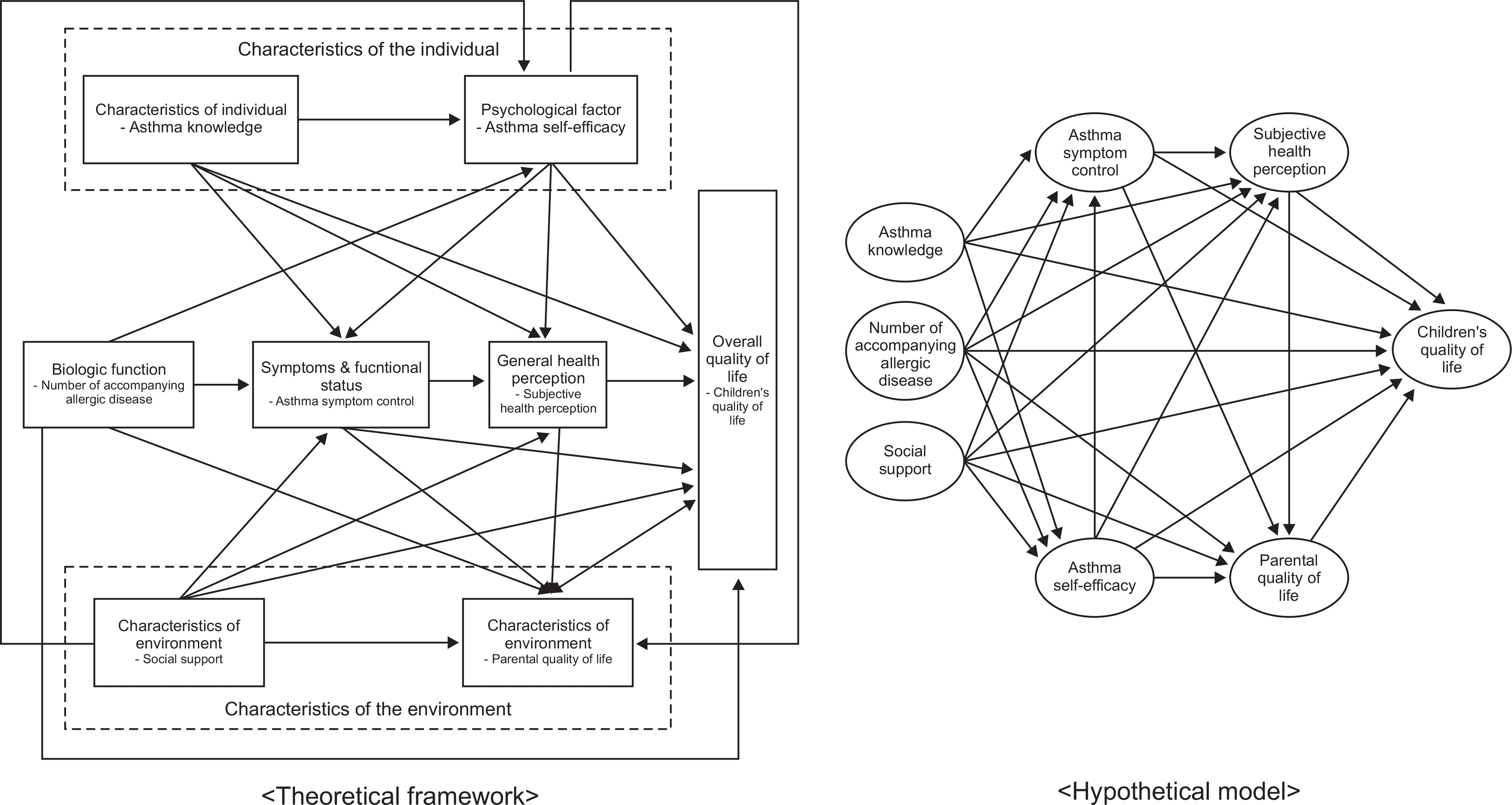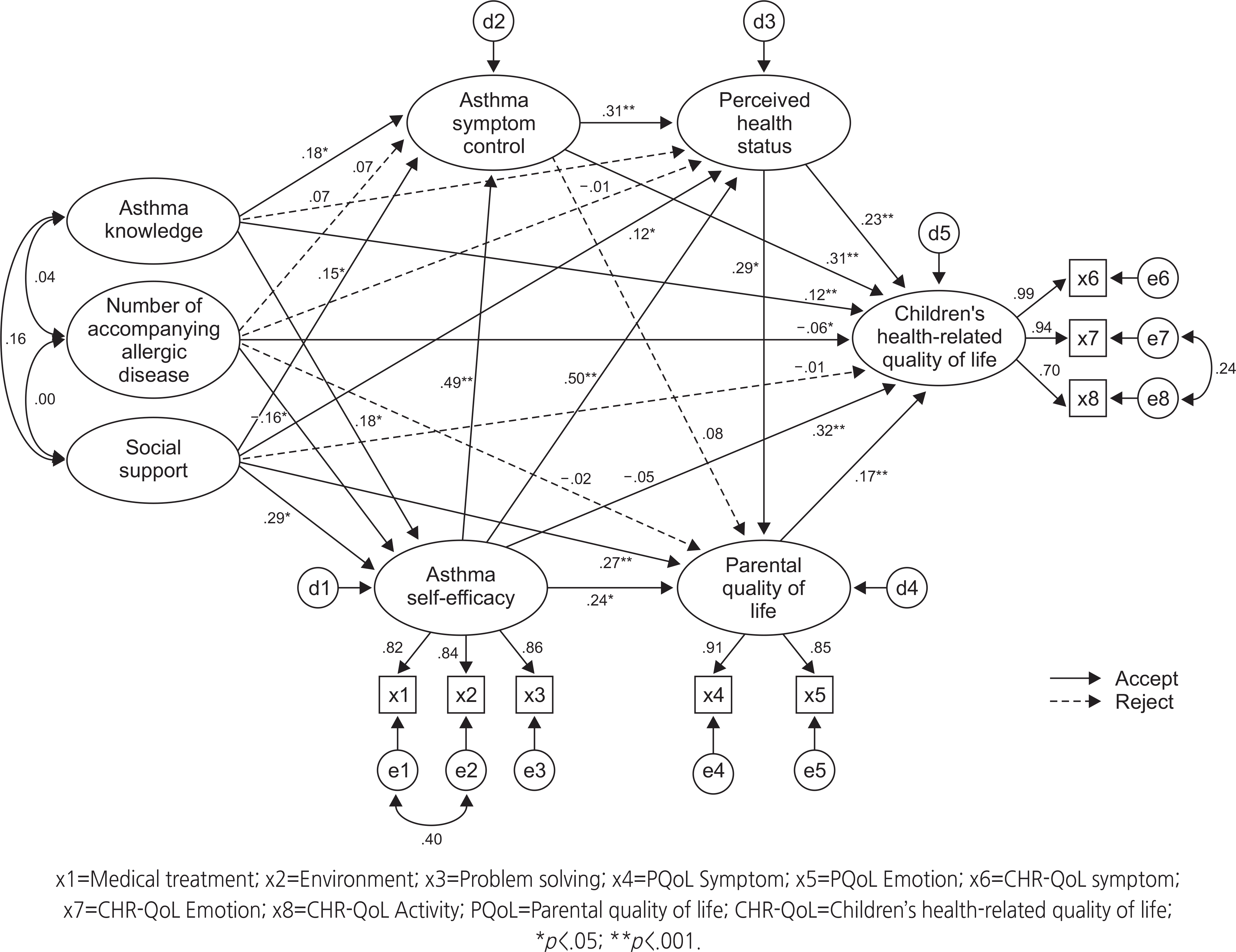Abstract
Purpose
This study aimed to construct and test a hypothetical model of the quality of life of school-age children with asthma based on the health-related quality of life model by Wilson and Cleary.
Methods
Data were collected from 205 pairs of pediatric outpatients diagnosed with asthma and their parents in Seoul and Gyeonggi-do from July 2016 to April 2017. The exogenous variables were asthma knowledge, number of accompanying allergic diseases, and social support. The endogenous variables were asthma self-efficacy, asthma symptom control, perceived health status, parental quality of life, and children's quality of life. For data analysis, descriptive statistics, factor analysis, and structural equation modeling were performed.
Go to : 
References
1. Network GA. The global asthma report 2014. Auckland: Global Asthma Network;2014. p. 769.
2. Fuchs O, Bahmer T, Rabe KF, von Mutius E. Asthma transition from childhood into adulthood. The Lancet Respiratory Medicine. 2017; 5(3):224–234. https://doi.org/10.1016/S2213-2600(16)30187-4.

3. MOHW. Press releases, major [allergic] disease, it many occur in children and adolescents [Internet]. Sejong: Ministry of Health and Welfare;c2017. [cited 2017 Sep 11]. Available from:. http://www.mohw.go.kr/front_new/al/sal0301vw.jsp?PAR_MENU_ID=04&MENU_ID=0403&CONT_SEQ=332411.
4. National Health Interview Survey. Ever having asthma and still having asthma for children under age 18 years, by selected characteristics: United States, 2014 (Table 1). Atlanta (GA): National Center for Health Statistics;c2004. [cited 2017 Sep 07]. Available from:. http://ftp.cdc.gov/pub/Health_Statistics/NCHS/NHIS/SHS/2014_SHS_Table_C-1.pdf.
5. Patel MR, Brown RW, Clark NM. Perceived parent financial burden and asthma outcomes in low-income, urban children. Journal of Urban Health. 2013; 90(2):329–342. https://doi.org/10.1007/s11524-012-9774-7.

6. Silva N, Carona C, Crespo C, Canavarro MC. Quality of life in pediatric asthma patients and their parents: a meta-analysis on 20 years of research. Expert Review of Pharmacoeconomics & Outcomes Research. 2015; 15(3):499–519. https://doi.org/10.1586/14737167.2015.1008459.

7. The WHOQOL Group. The development of the World Health Organization Quality of Life Assessment Instrument (the WHOQOL). John O, Willem K. Quality of Life Assessment: International Perspectives. Springer;1994. p. 41–57.
8. Matza LS, Swensen AR, Flood EM, Secnik K, Leidy NK. As- sessment of health-related quality of life in children: A review of conceptual, methodological, and regulatory issues. Value in Health. 2004; 7(1):79–92. https://doi.org/10.1111/j.1524-4733.2004.71273.x.
9. Wilson IB, Cleary PD. Linking clinical variables with health-related quality of life. A conceptual model of patient outcomes. JAMA. 1995; 273(1):59–65. https://doi.org/10.1001/jama.1995.03520250075037.

10. Everhart RS, Fiese BH. Asthma severity and child quality of life in pediatric asthma: A systematic review. Patient Education and Counseling. 2009; 75(2):162–168. https://doi.org/10.1016/j.pec.2008.10.001.

11. Kalyva E, Eiser C, Papathanasiou A. Health-related quality of life of children with asthma: Self and parental perceptions. International Journal of Behavioral Medicine. 2016; 23(6):730–737. https://doi.org/10.1007/s12529-016-9558-7.

12. Auger KA, Kahn RS, Davis MM, Simmons JM. Pediatric asthma readmission: Asthma knowledge is not enough? The Journal of Pediatrics. 2015; 166(1):101–108. https://doi.org/10.1016/j.jpeds.2014.07.046.

13. Kintner EK, Cook G, Marti CN, Allen A, Stoddard D, Harmon P, et al. Effectiveness of a school- and community-based academic asthma health education program on use of effective asthma self-care behaviors in older school-age students. Journal for Specialists in Pediatric Nursing. 2015; 20(1):62–75. https://doi.org/10.1111/jspn.12099.

14. Luskin AT, Chipps BE, Rasouliyan L, Miller DP, Haselkorn T, Dorenbaum A. Impact of asthma exacerbations and asthma triggers on asthma-related quality of life in patients with severe or difficult-to-treat asthma. The Journal of Allergy and Clinical Immunology: In Practice. 2014; 2(5):544–552. e1-2.https://doi.org/10.1016/j.jaip.2014.02.011.

15. Fedele DA, Grant DM, Wolfe-Christensen C, Mullins LL, Ryan JL. An examination of the factor structure of parenting capacity measures in chronic illness populations. Journal of Pediatric Psychology. 2010; 35(10):1083–1092. https://doi.org/10.1093/jpepsy/jsq045.

16. Hilliard ME, Monaghan M, Cogen FR, Streisand R. Parent stress and child behaviour among young children with type 1 diabetes. Child: Care, Health and Development. 2011; 37(2):224–232. https://doi.org/10.1111/j.1365-2214.2010.01162.x.

17. Hockenberry MJ, Wilson D. Wong’s nursing care of infants and children. 9th ed. London: Elsevier Health Sciences;2014. p. 646–653.
18. Villalonga-Olives E, Kawachi I, Almansa J, Witte C, Lange B, Kiese-Himmel C, et al. Pediatric health-related quality of life: A structural equation modeling approach. PLoS One. 2014; 9(11):e113166. https://doi.org/10.1371/journal.pone.0113166.

19. Foster Page LA, Thomson WM, Ukra A, Farella M. Factors influencing adolescents’ oral health-related quality of life (OHRQoL). International Journal of Paediatric Dentistry. 2013; 23(6):415–423. https://doi.org/10.1111/ipd.12011.

20. Kae Kintner E. Testing the acceptance of asthma model with children and adolescents. Western Journal of Nursing Research. 2007; 29(4):410–431. https://doi.org/10.1177/0193945907299657.

21. Annett RD, Turner C, Brody JL, Sedillo D, Dalen J. Using structural equation modeling to understand child and parent perceptions of asthma quality of life. Journal of Pediatric Psychology. 2010; 35(8):870–882. https://doi.org/10.1093/jpepsy/jsp121.

22. Eilayyan O, Gogovor A, Mayo N, Ernst P, Ahmed S. Predictors of perceived asthma control among patients managed in primary care clinics. Quality of Life Research. 2015; 24(1):55–65. https://doi.org/10.1007/s11136-014-0700-1.

23. Cho AR, Lee SY, Kim YH, Yoo Y, Yang HJ, Lee JS, et al. Multicenter study on factors influencing the quality of life of asthmatic children and their caregivers. Pediatric Allergy and Respiratory Disease. 2012; 22(1):37–44. https://doi.org/10.7581/pard.2012.22.1.37.

24. Cevik Guner U, Celebioglu A. Impact of symptom management training among asthmatic children and adolescents on self-efficacy and disease course. Journal of Asthma. 2015; 52(8):858–865. https://doi.org/10.3109/02770903.2015.1010732.

25. Mickley KL, Burkhart PV, Sigler AN. Promoting normal development and self-efficacy in school-age children managing chronic conditions. Nursing Clinics of North America. 2013; 48(2):319–328. https://doi.org/10.1016/j.cnur.2013.01.009.

26. Kaul T. Helping African American children self-manage asthma: The importance of self-efficacy. Journal of School Health. 2011; 81(1):29–33. https://doi.org/10.1111/j.1746-1561.2010.00554.x.

27. La Greca AM, Bearman KJ, Moore H. Peer relations of youth with pediatric conditions and health risks: Promoting social support and healthy lifestyles. Journal of Developmental and Behavioral Pediatrics. 2002; 23(4):271–280. https://doi.org/10.1097/00004703-200208000-00013.

28. Vila G, Hayder R, Bertrand C, Falissard B, De Blic J, Mouren-Simeoni MC, et al. Psychopathology and quality of life for adolescents with asthma and their parents. Psychosomatics. 2003; 44(4):319–328. https://doi.org/10.1176/appi.psy.44.4.319.

29. Houben-van Herten M, Bai G, Hafkamp E, Landgraf JM, Raat H. Determinants of health-related quality of life in school-aged children: A general population study in the Netherlands. PLoS One. 2015; 10(5):e0125083. https://doi.org/10.1371/journal.pone.0125083.

30. Hwang SJ, Min JW, Lee SM, Kim CY, Yum MK, Lee HB, et al. A pilot study of comparisons between 1999 and 2007 data on childhood asthma caregiver’s quality of life questionnaire. Pediatric Allergy Respiratory Disease. 2008; 18(2):174–183.
31. Woo JP. The concept and understanding of structural equa- tion modeling with AMOS 4.0-20.0. Seoul: Hannarae;2012. p. 276–277.
32. Al-Motlaq M, Sellick K. Development and validation of an asthma knowledge test for children 8-10 years of age. Child: Care, Health and Development. 2011; 37(1):123–128. https://doi.org/10.1111/j.1365-2214.2010.01133.x.
33. Nolten PW. Conceptualization and measurement of social support: The development of the student social support scale [dissertation]. Madison: University of Wisconsin;1994. p. 1–121.
34. Lee MR. A study on the social support system to influence on the high shool students’ adaptation to school life [master’s thesis]. Daegu: Graduate School, Taegu University;2000. p. 1–72.
35. Juniper EF, Guyatt GH, Feeny DH, Ferrie PJ, Griffith LE, Townsend M. Measuring quality of life in the parents of children with asthma. Quality of Life Research. 1996; 5(1):27–34. https://doi.org/10.1007/BF00435966.

36. Cha JK, Oh JW, Hong SJ, Lee HR, Lee MI, Kim KE, et al. Development and multicenter study on Korean pediatric asthma caregiver’s quality of life questionnaire (KPACQLQ). Journal of Asthma, Allergy and Clinical Immunology. 2000; 20(3):480–491.
37. Liu AH, Zeiger R, Sorkness C, Mahr T, Ostrom N, Burgess S, et al. Development and cross-sectional validation of the Childhood Asthma Control Test. Journal of Allergy and Clinical Immunology. 2007; 119(4):817–825. https://doi.org/10.1016/j.jaci.2006.12.662.

38. Schlösser M, Havermans G. A self-efficacy scale for children and adolescents with asthma: Construction and validation. Journal of Asthma. 1992; 29(2):99–108. https://doi.org/10.3109/02770909209059878.

39. Anderson M. Effects of an inpatient asthma education program for children and adolescents on self-efficacy scores [dissertation]. Arlington: The University of Texas at Arlington;1997. p. 1–89.
40. Yoon YM. Effects of an asthma camp program on self care behavior of asthmatic children [dissertation]. Seoul: The Graduate School, Korea University;2001. p. 1–116.
41. Ravens-Sieberer U, Gosch A, Rajmil L, Erhart M, Bruil J, Duer W, et al. KIDSCREEN-52 quality-of-life measure for children and adolescents. Expert Review of Pharmacoeconom- ics & Outcomes Research. 2005; 5(3):353–364. https://doi.org/10.1586/14737167.5.3.353.

42. Hong SD, Yang JW, Jang WS, Byun H, Lee MS, Kim HS, et al. The KIDSCREEN-52 quality of life measure for children and adolescents (KIDSCREEN-52-HRQOL): Reliability and validity of the Korean version. Journal of Korean Medical Science. 2007; 22(3):446–452. https://doi.org/10.3346/jkms.2007.22.3.446.

43. Juniper EF, Guyatt GH, Feeny DH, Ferrie PJ, Griffith LE, Townsend M. Measuring quality of life in children with asthma. Quality of Life Research. 1996; 5(1):35–46. https://doi.org/10.1007/BF00435967.

44. Cha JK, Oh JW, Hong SJ, Lee HR, Lee MI, Kim KE, et al. Development and multicenter study on Korean pediatric asthma quality of life questionnaire (KPAQLQ). Journal of Asthma, Allergy and Clinical Immunology. 2000; 20(3):492–508.
45. Kang H. Discussions on the suitable interpretation of model fit indices and the strategies to fit model in structural equation modeling. Journal of the Korean Data Analysis Society. 2013; 15(2):653–668.
46. Yoos HL, Kitzman H, McMullen A, Sidora K. Symptom perception in childhood asthma: How accurate are children and their parents? Journal of Asthma. 2003; 40(1):27–39. https://doi.org/10.1081/JAS-120017204.

47. Walker J, Winkelstein M, Land C, Lewis-Boyer L, Quartey R, Pham L, et al. Factors that influence quality of life in rural children with asthma and their parents. Journal of Pediatric Health Care. 2008; 22(6):343–350. https://doi.org/10.1016/j.pedhc.2007.07.007.

48. Osman LM, Baxter-Jones AD, Helms PJ. EASE Study Group. Parents’ quality of life and respiratory symptoms in young children with mild wheeze. EASE Study Group. European Respiratory Journal. 2001; 17(2):254–258.
49. Moonie S, Huang X, Sterling DA. Quality of life estimation with structural equation modeling in school aged children with asthma. Global Health Governance. 2009; 3(1):1–16.
Go to : 
Table 1.
General and Disease - Specific Characteristics of the Children and Their Parents (N=205)
Table 2.
Descriptive Statistics of the Measured Variables (N=205)
Table 3.
Standardized Direct, Indirect, and Total Effects for the Hypothetical Model




 PDF
PDF ePub
ePub Citation
Citation Print
Print




 XML Download
XML Download